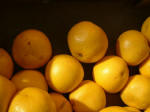pomelos rose

Today I have traveled from Roanoke Virginia to France to China to Spain to Mexico and then to my memories in search of an illusive pomelo rose. You might say I have circled the globe to find this succulent globe that is not only healthy but its roots go back 20 million years. So I have not only traveled through space I have traveled through time... who could ask for anything more.
2 pomelos roses (ou pamplemousses)3 avocats pas trop mûrs1 cuillère à soupe de moutarde au citron2 cuillères à soupe d'huile d'olive1 cuillère à soupe de vinaigre de vinQuelques brins de ciboulette fraîcheSel, poivre blanc
PréparationPelez les pamplemousses à vif au dessus d'un bol pour en récolter le jus.Puis "déshabillez" les quartiers de pamplemousses de leur peau et posez-les dans un saladier. Coupez-les en deux s'ils sont trop gros pour être mangés d'une bouchée.Pelez les avocats et taillez-les en gros cubes. Placez-les dans le saladier.Dans le bol avec le jus de pamplemousse, réalisez la vinaigrette en ajoutant la mouarde, l'huile et le vinaire. Salez, poivrez.Versez la vinaigrette sur l'ensemble, remuez très déicatement. Clairsemez un peu de ciboulette fraîche coupée et dégustez immédiatement.
Pour des raisons esthétiques, il est conseillé de préparer cette salade au dernier moment sinon les avocats s'oxydent et noircissentOn pourra ajouter quelques petites crevettes qui complètent bien l'ensemble.
A grapefruit by any other same is pamplemousse or pomelo
How does one become a rose of the grapefruit? By being a red grapefruit
Does a red grapefruit by any other name taste as lush and rich and filled with promise? Well it does have the promise of health...
Red fruit are loaded with beneficial plant compounds called phytochemicals, which preserve your health in several ways. These phytochemicals can keep your brain agile as you age, guard against heart disease and cancer, ease arthritis, and ward off urinary tract infections and ulcers. Many phytochemicals are antioxidants, which fight off health-damaging free radicals. http://www.findarticles.com/p/articles/mi_m0NAH/is_4_32/ai_85174715
As I began my journey I traveled to france and saw a painter - a very intense middle-aged white man who painted with an african flare. I traveled further to find out that he was painting a woman with a grapefruit with a ruby red inner flesh. His symbology became more interesting.
Then the recipes in French and then studying the citrus from ugly fruits (grin) to sour or bitter oranges in Mexico which were imported by Spain.
Which reminded me of a story or two.
When I married my husband I found a poem written by his father where he wrote (translated) "my son is a bitter orange."
I did not understand his symbolism until today. What a wonderful adventure free write has given me.
I discovered that in Mexico the bitter orange is used for medicinal purposes.
Sour orange juice is antiseptic, anti-bilious and hemostatic. Africans apply the cut-open orange on ulcers and yaws and areas of the body afflicted with rheumatism. In Italy, Mexico and Latin America generally, decoctions of the leaves are given for their sudorific, antispasmodic, stimulant, tonic and stomachic action. The flowers, prepared as a sirup, act as a sedative in nervous disorders and induce sleep. An infusion of the bitter bark is taken as a tonic, stimulant, febrifuge and vermifuge. http://www.hort.purdue.edu/newcrop/morton/sour_orange.html
And I remembered traveling the Yucatan and I would visit with Aunt Lucilla who told me of using bitter orange (a sour orange with a red sour flesh reminiscent of the pomelos rose which brought me to this memory) to heal so many different health issues in the Mexican culture. You see my husband Mark is descended from a long line of Yaqui shamans and thus when his father wrote about his son being a bitter orange, he meant the birth of his son was his healing.
Did you know:
citrus grew in Asia 20 million years ago?
citrus was first mentioned in literature in 2400 B.C.?
the first varieties of citrus were bitter and not edible?
each person in the U.S. eats about 12.5 lbs (5.6 kilos) of citrus per year!!!
citrus is the most widely grown crop in the world!
Brazil produces the largest amount of oranges and grapefruits in the world!
in Florida there are approximately 10.3 million citrus trees on 853,000 acres of land!
there is more fiber in an orange than in most other fruits and veggies!
Florida oranges may be greener than California oranges because the night temperatures in Florida are warmer, which causes more chlorophyll to migrate into the peel; they are still ripe and sweet though.
British sailors used to be called “Limeys” because they ate citrus to prevent scurvy on long sea voyages.
if you plant a single seed from an orange you will probably get more than one plant growing from it.
immature growth on most citrus trees will have sharp thorns. These tend to break off as the wood gets older.
Myriam Maytorena, M.Ed.Life with Mother;A Journey of Love, Death and Rebirthhttp://lifewithmother.com/ http://manifestreality.com/http://myriamsmuse.blogspot.com/


0 Comments:
Post a Comment
<< Home